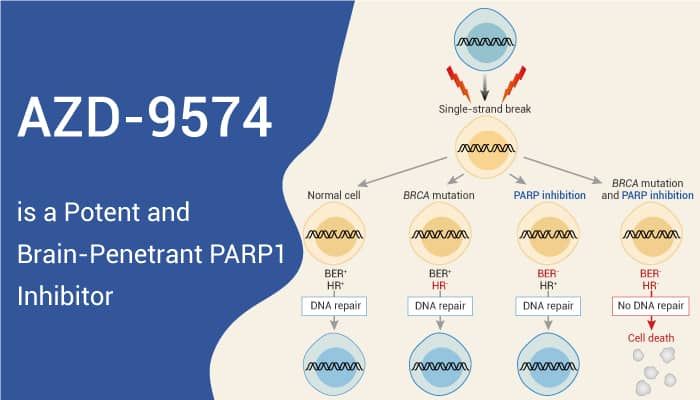The Poly (ADP-ribose) polymerase (PARP) family has numerous essential functions. PARP plays roles in cellular processes such as transcription, chromatin remodeling, DNA damage response, and repair. DNA double-strand breaks (DSBs) are the most deleterious form of DNA damage.
Besides, DSBs can be repaired by homologous recombination repair (HRR) or non-homologous end joining (NHEJ). SSB repair needs PARP1 and PARP2. While PARP1 is also involved in the DSBs repair and replication fork damage. Furthermore, PARP1 inhibition may lead to an antiproliferative effect.
In this article, we will introduce a potent PARP1 inhibitor, AZD-9574.

AZD-9574 is a potent and brain penetrant PARP1 inhibitor. And it shows >8000-fold selectivity for PARP1 compared to PARP2/3/5a/6. How does AZD-9574 “work”? AZD-9574 acts by selectively inhibiting and trapping PARP1 at the sites of SSBs. Moreover, AZD-9574 is an anti-cancer agent. And it has the potential for HRD+ breast cancer and advanced solid malignancies research.
AZD-9574 inhibits PARP1 enzymatic activity with IC50s range between 0.3-2 nM in all tested cell lines irrespective of the homologous recombination repair (HRR) status[1].
In isogenic cell lines pairs confirms higher potency and selectivity towards HRR-deficient (HRD+) models (DLD1 BRCA2-/-; SKOV-3 BRCA2-/- and SKOV-3 PALB2-/-). The IC50 in BRCA2-/- DLD1 cells is 1.38 nM compared to IC50 >40 µM BRCA2 wt cells.
In vivo, AZD9574 shows a dose-dependent efficacy in a BRCA1 mutant MDA-MB-436 xenograft model. In an intracranial xenograft model of breast cancer brain metastases. AZD-9574 (3 mg/kg) exhibits sustained tumor growth suppression resulting in a significantly extended survival of tumor-bearing mice.
Collectively, AZD9574 is a potential compound for HRD+ breast cancer research whose disease has spread to the brain.
Reference:
Kunzah Jamal, et al. Cancer Res (2022) 82 (12_Supplement): 2609.